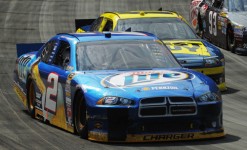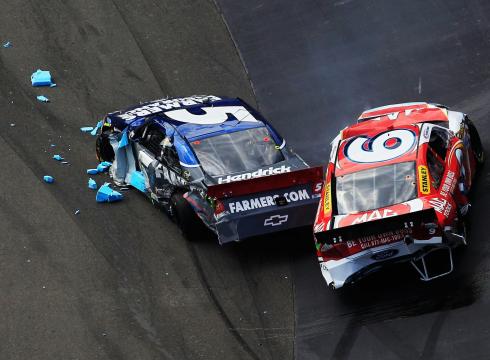[media-credit name=”Credit: Justin Edmonds/Getty Images for NASCAR” align=”alignright” width=”247″] [/media-credit]To leave the Bristol Motor Speedway without some form of controversy is unheard of.
[/media-credit]To leave the Bristol Motor Speedway without some form of controversy is unheard of.
The Tennessee short track advertising controversy, with beating and banging making the half-mile what it is. Feelings get hurt here and some of the sports most memorable moments happen on the BMS high banks.
The last two Bristol races however, have brought forth controversy of a different kind. Last August it was the scoring lines on pit road that some drivers cried foul over, saying the lines were too far apart and it allowed drivers such as Brad Keselowski and Matt Kenseth to speed past.
Keselowski, who went on to win that race, took exception, saying that wasn’t the reason he had won. This time around Keselowski won in spite of the controversy that was on everyone’s mind: restarts.
Keselowski and Matt Kenseth raced each other hard and clean the last half of the Food City 500, trading the lead back and forth. On a late restart though a video review showed Kenseth, running second, had beaten Keselowski to the start-finish line.
By rule, the second place driver is not to beat the leader on the restart. Many watching went into an uproar and called for Kenseth to be black-flagged. NASCAR stayed silent and let them race, something that both drivers were thankful for afterwards.
“I knew it was close,” said Kenseth. “But here is the thing. When you get to the second line, they say the race is on. I know we took off a little bit early. Quarter throttle, I’m waiting for him [Keselowski]. NASCAR actually has the data, you can look at it, kind of cool.”
Kenseth was referring to the restart lines posted on the wall. It provides drivers with a visual of where they can start accelerating. When Keselowski didn’t get up to speed fast enough in the restart zone it was fair game for Kenseth to beat him to the start-finish line, which he did and ended up taking the lead.
“I didn’t floor it till I got to the start-finish line,” said Kenseth. “I don’t know if he was trying to let me beat him on purpose. I was half throttle for five car lengths. I was finally, I got to go or Martin [Truex] or whoever was behind me was going to go around me.
“It was way past that line and we still weren’t wide open. I think he was just playing a little game, trying to get me out there so I had to brake check. I just watched him and tried to get to the line barely behind him.”
Compared to how badly some drivers have beaten the leader to the line in the past, Kenseth nudging past Keselowski by a few inches wasn’t so bad. Of course, a rule is a rule as they say and many wanted to see it enforced.
Keselowski though, wasn’t among them. He, like Kenseth, didn’t see anything wrong with what had happened, knowing that the restart was very close. According to Keselowski, the driver who restarts second, if he does it right, can have an advantage.
“It’s such a ball strike call, I don’t know,” he said. “I hate to be on NASCAR’s side that he beat you to the start-finish line. I can tell you there’s two yellow lines on the wall. Visually you can’t tell if somebody goes 50 foot before ‘em or right at ‘em. It’s damn near impossible to visually tell that.
“Even if you had telemetry, it’s hard to tell it. It’s very subjective. I think when things are as subjective as that is, a ‘no’ call is a right call.”
With no penalties applied Keselowski went on to win his first race of the year, fifth career and second straight at Bristol. Kenseth finished second, his second top 10 of the season.
And just as they did last fall, they both will leave others to debate the day’s events as they move on and prepare for the upcoming week. According to the two of them, what happened Sunday was a non-issue.
“I know I’ve seen moves on restarts, without picking any one particular guy, where guys have jumped it by a mile, I mean a hundred some foot,” said Keselowski. “You watch it on TV. I know what I saw in the car. I go back and watch it on TV and it doesn’t look it.
“I can’t imagine that the perspective of an official up in the pit box or press box, wherever they’re at, or even TV, from what I can tell, can pick that stuff out. I think there has to be some leniency. If a guy beats you by a full car length to the start-finish line, something is going on.
“I don’t think we’re seeing that. I think if you’re close, NASCAR has been cool enough about it to let it go, and I respect that.”







